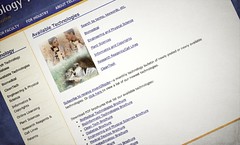The tech transfer process: buffering science from commercialism
By Kristopher A. Nelson
in
May 2011
700 words / 3 min.
Tweet
Share
Technology transfer offices at universities are key players in the process of putting technology to work. They facilitate the sometimes difficult translation of academic discoveries into private, saleable technology. The offices also serve as a buffer between the demands of private enterprise and the Mertonian ideals of the academic “ivory tower,” and the technology transfer process reflects this.
Please note that this post is from 2011. Evaluate with care and in light of later events.
 Technology transfer offices at universities are key players in the process of putting technology to work. They facilitate the sometimes difficult translation of academic discoveries into private, saleable technology. The offices also serve as a buffer between the demands of private enterprise and the Mertonian ideals of the academic “ivory tower,” and the technology transfer process reflects this. In fact, much of the economic “waste” that occurs during the process is exactly what creates and maintains this buffer.
Technology transfer offices at universities are key players in the process of putting technology to work. They facilitate the sometimes difficult translation of academic discoveries into private, saleable technology. The offices also serve as a buffer between the demands of private enterprise and the Mertonian ideals of the academic “ivory tower,” and the technology transfer process reflects this. In fact, much of the economic “waste” that occurs during the process is exactly what creates and maintains this buffer.
At least at the University of California, San Diego, the process involves tech transfer officers–6 for the life sciences, 3 for other kinds of technology, and 1 who does both–reviewing the research done at UCSD. They look for innovations that may be potentially turned into marketable intellectual property. According to Dr. Montisano, a life sciences tech transfer officer at UCSD, they do not “police faculty.” As a result, they sometimes do not learn of new technology until after publication, which immediately causes the loss of international patent rights, and puts U.S. patent rights on a 1-year timeline.
If they do manage to intercept the technology in time–either through researchers submitting it to them directly, or by discovering it after publication–they review the innovation, and may file a provisional patent application to preserve their rights (this allows publication). They then have a year to convert that to a full patent.
Once they have provisional protection in place, the office looks for a good licensee for the technology. They first put a description of the innovation on the UCSD web site, making it available to interested parties who may be seeking such technology. They also identify and actively target potential companies for licensing, focusing on those they know do work in the field and who may be interested in the technology.
The point, according to Dr. Montisano, is to get the technology out into the world through commercialization, not to make a fortune, and UCSD looks for licensees on this basis. Such a focus emphasizes the public nature of the university, and emphasizes the role of the tech transfer office as the buffer zone between private and public enterprise–they license innovations for money, but do so with a goal of benefitting the public.
Additionally, the distribution process also protects researchers from undue market influences. The university owns the invention, not the professor, or grad student, or research tech. 50% of the incoming money goes to the university as a whole, while the remaining 50% is split by the department between those who developed the invention and the department. Thus, even the incoming money is diluted and sifted, buffering the researchers themselves from direct contact with the commercial players.
More rules are in place when it comes to researchers profiting or being overly involved in the commercial enterprise while retaining their role at the university. A university researcher cannot be the executive of a licensee company nor a board member, but can sit on a scientific advisory board. Such a researcher can own shares in the company, though, suggesting at least one way for the market to more directly intrude on an individual academic. Nonetheless, to be full involved in directing a licensee, a researcher must leave the university and their post as an academic and fully enter the commercial world.
Finally, the office itself is insulated from the money involved. Although they bring in millions to the University of California, UCSD’s technology transfer office is funded entirely by the state. No funding comes through a percentage of license fees and no officer receives specific bonuses for signing deals. This emphasizes their focus on the public service of commercializing technology, rather than on their use as market-enablers.
